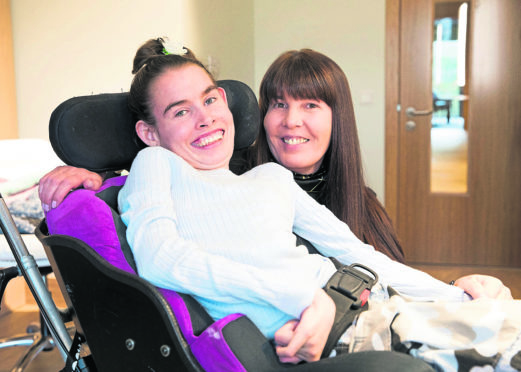
The simple act of having your hair done or being pampered with a massage can work wonders to brighten and lift the mood.
Now, the benefits of beauty treatments are being hailed by patients receiving palliative care at one of Scotland’s newest hospices.
When the Prince & Princess of Wales Hospice opened its doors in Glasgow last year, the team of carers, doctors and nurses knew they wanted to provide more than just medical support, and the building was kitted out with a unique pamper suite, where patients can receive complementary therapies, including haircuts, massage, reiki and reflexology.
Staffed exclusively by kind-hearted volunteers, the makeshift beauty salon enables patients with life-limiting illnesses to relax, recharge and feel renewed – something which has been transformative for Leona Davidson, 29, who has been attending the suite since it opened.
When she was just 10, Leona was diagnosed with a rare genetic neurological condition, Pantothenate Kinase-Associated Neurodegeneration (PKAN) Disease, which causes progressive loss of movement, muscle degeneration and postural changes.
Leona’s mum Angela, 48, says visiting the hospice to have her hair done and socialise with staff has been vital in maintaining her independence and making her feel like any other young woman, especially since her condition took away her ability to talk.
“People often assume that palliative care is doom and gloom, and everything is focused on your health condition,” explained Angela, who lives in Glasgow and is also mum to Morgan, 21.
“But the pamper suite doesn’t look any different from a regular salon and it’s such a focal point for Leona when she visits.
“I want her to think about having her hair done, getting glam or enjoying a massage when she’s going there, rather than thinking of the hospice as a place where she only goes when she’s not well. We’ve had challenges going to everyday spas – often they aren’t built for people in wheelchairs – so being able to just drop into the salon here is amazing.
“Caroline, the hairdresser, is one of Leona’s favourite people and they have built such a strong bond.”
Staff at the hospice say that while they can’t “add days to life” they can “add life to days” and the pamper suite, which was installed in the Bellahouston Park centre thanks to funding from the ScottishPower Foundation, is a key part of their mission.
“Health and wellbeing are interlinked and as such we believe that offering our patients the opportunity to have their hair styled, a massage or reiki is an important part of their general feeling of wellbeing and happiness,” explained Gillian Sherwood, director of clinical services at the Hospice.
“We have seen patients transform once they have had their hair washed and professionally styled. It contributes to their sense of self and can really lift their mood.
“These complementary therapies can also help alleviate some patients’ physical symptoms, too.
“Massage has been found to help reduce muscle aches and reiki can help reduce tension and stress, which many patients and their families experience.
“We are so grateful to our team of volunteers who give up their time freely to make a difference in our patients and their families’ lives.”

Enjoy the convenience of having The Sunday Post delivered as a digital ePaper straight to your smartphone, tablet or computer.
Subscribe for only £5.49 a month and enjoy all the benefits of the printed paper as a digital replica.
Subscribe